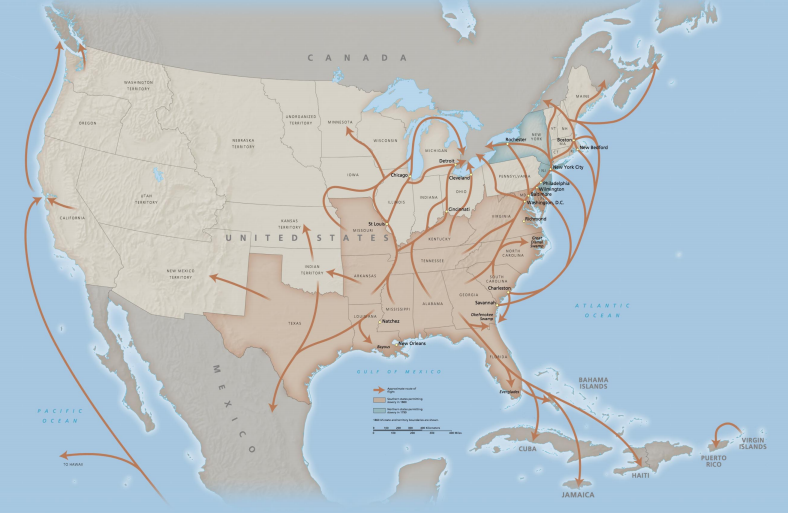A United States map showing the differing routes that freedom seekers would take to reach freedom – National Park Service map
By Ken Coleman
www.michiganadvance.com
A pair of Michigan burial sites are among the new National Park Service’s 16 listings to the National Underground Railroad Network to Freedom.
The announcement was made Tuesday of the historic Elijah Fish and George Taylor sites, located at Greenwood Cemetery in Birmingham.
“It’s fitting to welcome new additions to the National Underground Railroad Network to Freedom as we celebrate Harriet Tubman’s 200th birthday. Like Harriet Tubman, the freedom seekers and allies highlighted in each Network to Freedom listing remind us of what can be accomplished when people take action against injustice,” said Diane Miller, national program manager of the Network to Freedom. “Each listing holds a unique part of the Underground Railroad story, and we look forward to working with members to amplify the power of these places.”
Taylor was an African American who escaped slavery in Kentucky and later lived in Michigan. He died in 1901. He and his wife, Eliza, have unmarked gravesites at the cemetery. Fish, who was white, was an abolitionist who fought the American institution of slavery during the 1800s. He founded First Presbyterian Church in Birmingham.
Both men participated in the Underground Railroad movement, an intricate sets of transportation routes that connected the South to the North and provided a pathway for Black slaves who sought freedom.
The set of listings across 11 states join 700 sites, facilities and programs already in the Network. They provide insight into the diverse experiences of freedom seekers who bravely escaped slavery and those who assisted them.
The other new Network to Freedom listings are:
Marianna Expedition on Santa Rosa Island (Florida, Gulf Islands National Seashore)
Winterset Cemetery (Iowa)
Dinsmore Homestead (Kentucky)
LeCompte Plantation (Louisiana)
Emmanuel Prudhomme Plantation (Louisiana)
Mass Escape at Mackall Plantation (Maryland)
Port Tobacco Jail Sites (Maryland)
St. Stephens A.M.E. Church Cemetery, (Maryland)
Robert Gould Shaw 54th Massachusetts Regiment Memorial (Massachusetts)
Huntoon-Van Rensalier Underground Railroad Site (New Jersey)
Presbyterian Plane Street Colored Church (New Jersey)
Rev. Robert Everett and Family Gravesite, Capel Ucha Welsh Congregational Church Cemetery (New York)
Spring Grove Cemetery (Ohio)
Cozad-Bates House Interpretive Center (Ohio)
Destination Freedom Underground Railroad Walking Tour (Pennsylvania)
Ken Coleman covers Southeast Michigan, economic justice and civil rights. He is a former Michigan Chronicle senior editor and served as the American Black Journal segment host on Detroit Public Television. He has written and published four books on black life in Detroit, including Soul on Air: Blacks Who Helped to Define Radio in Detroit and Forever Young: A Coleman Reader. His work has been cited by the Detroit News, Detroit Free Press, History Channel and CNN.
Additionally, he was an essayist for the award-winning book, Detroit 1967: Origins, Impacts, Legacies. Ken has served as a spokesperson for the Michigan Democratic Party, Detroit Public Schools, U.S. Sen. Gary Peters and U.S. Rep. Brenda Lawrence. Previously to joining the Advance, he worked for the Detroit Federation of Teachers as a communications specialist. He is a Historical Society of Michigan trustee and a Big Brothers Big Sisters of Metropolitan Detroit advisory board member.




